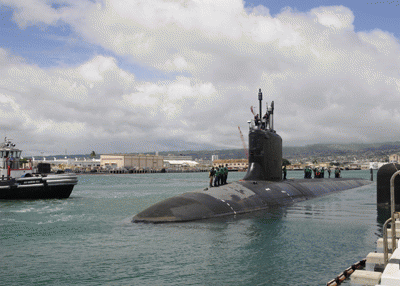It looks like the U.S. Navy is playing fast and loose with
the new military exercise regulations in areas with a concentration of marine
mammals that it has received from the National Marine Fisheries Service. One seldom sees a nuclear submarine on the surface of the
ocean except when they are going into homeports, such as Pearl Harbor, Hawaii. But, this weekend I saw three U.S. nuclear
submarines on the surface with crewmen sunning themselves on the deck -- in a
protected national marine sanctuary, no less!
I was whale watching off the Hawaiian island of Maui,
Sunday, February 9, 2014 and was shocked to see three U.S. Navy nuclear
submarines surface and remain about a mile offshore from the town of Lahina in
the shallow waters of the protected Hawaiian Islands Humpback Whale National
Marine Sanctuary.
December to March is
when the greatest concentration of humpback whales in the world gather to calve
in the shallow basin between the islands of Maui, Lanai, Ko'olawhe and Molokai. Yet, this is the time that the U.S. Navy has
chosen to have military exercises and have brought fast moving, sonar emitting
nuclear submarines into the protected sanctuary.
Whale watching is one of the biggest tourist attractions of
Hawaii and, under strict guidelines, dozens of small boats each day take
tourists out to watch the whales. The
basin off Maui has the largest concentration of small commercial boats for
whale watching in the Hawaiian Islands.
Almost 13 years ago to the day, on February 9, 2001, the
U.S.S. Grenville, a nuclear submarine conducting a rapid ascent practice, surfaced
off Honolulu and came up under a Japanese student fishing boat the Ehime Maru, a
Japanese maritime student training vessel, breaking the 191-foot ship apart and
killing nine of the 35 on board (four were high school students) and sending the
ship to the bottom of the ocean with the nine bodies. Because of the diplomat crisis over the
sinking of the training vessel, the U.S. Navy conducted one of the largest
salvage missions in its history to recover the bodies and move the ship to its
final resting point 12 miles off Honolulu.
In late January, 2014, the National Resources Defense Council
filed a lawsuit against the National Marine Fisheries Service for violation of
multiple federal laws by allowing the Navy to increase sonar and live-fire
training in Hawaii and California for the next five years. The fisheries service decision allows the
Navy's training exercises to "incidentally" kill up to 13 marine mammals
annually in the training areas over the next five years and cause up to 1.7
million annual incidents of low-level harassment, which includes potential
disruption of nursing and breeding. The
Navy also asked for authorization to produce up to 266 annual incidents that
could result in injuries to marine mammals.
The NRDC's lawsuit argues that both the fisheries service and the Navy are ignoring the "best available science" in their findings, stating that the noise from sonar, underwater demolition and pile driving will cause significant long-term damage to whales and other marine mammals. The most intense underwater sounds used in U.S. Navy training are produced by anti-submarine warfare sonar and explosives.
The U.S. Navy's 456-page 2012 report Biological Opinion and Conference Report on U.S. Navy Hawaii-Southern
California Training and Testing 2013-2018
concedes that the sounds are within the audible ranges of most whales, but that
the sounds are limited in time, area and frequency with sonar pulses lasting up
to a few seconds each and anti-submarine sonar transmitting only a few times
per minute.
I called the public affairs office of the U.S. Navy in the Pacific and
asked if they could provide me with the names of the three submarines. I was told that the Navy's concern for
operational security of the submarines did not allow them to reveal the
names. When I asked if having three
submarines surface in one of the most visible and trafficked area in Hawaii and
remain on the surface for hours didn't compromise the operational security of
submarines, I was met with silence.
For the safety of whales and humans, the U.S. Navy should stop
military exercises for its nuclear submarines and other naval vessels in the congested
waters around the Hawaiian Islands.







